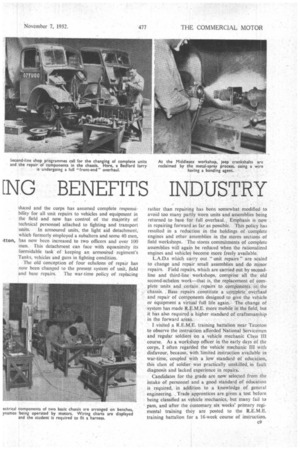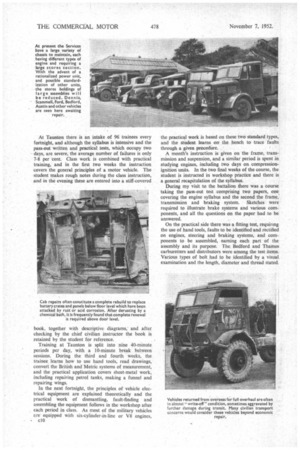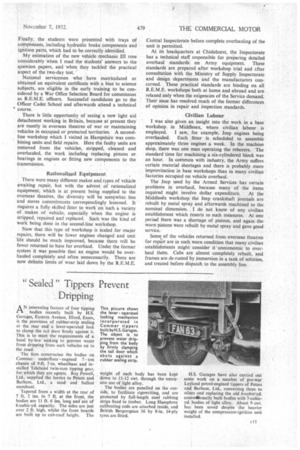R.E.M.E. TRA
Page 46

Page 47

Page 48

Page 49

If you've noticed an error in this article please click here to report it so we can fix it.
[NC BENEFITS INDUSTRY
Evidence of the Influence of Sound Commercial Practice in New R.E.M.E. Organization and Training Methods
SINCE its foimation just 10 years ago the responsibilities of the Corps of Royal Electrical and Mechanical Engineers have grown considerably as a result of the increased complexity of the technical equipment of the Army and it has now become the third largest corps. R.E.M.E. is responsible for the inspection and repair of all Army technical equipment from radar to artillery, Tanks and vehicles, and was formed by an amalgamation in October, 1942, of the engineering side of the R.A.O.C., the transport repair facilities of the R.A.S.C. and the Electrical and Mechanical side of the Royal Engineers.
Inevitably, during the War, the time available for training recruits to become fitters and other skilled tradesmen was short and instruction had to be restricted to the bare essentials. Now, under normal peacetime conditions, National Servicemen are given a comprehensive training, together with practical experience in the field, with the result that when they return to civilian life they are fully skilled in fault finding and repair. Full opportunity is given to all personnel to continue part-time study to obtain higher technical qualifications.
In the early days, R.E.M.E. was reinforced with fully trained personnel under the Engineers Registeation Act, and many of these "civilians in uniform" acquired responsible positions and subsequently were granted regular Army commissions. Their civilian experience has been used advantageously in the working of the corps and the link is maintained by attaching young regular officers to civilian factories for periods of up to 18 months to give them tuition in modern manufacturing technique and works administration. .
The general direction of R.E.M.E. and its big labour force is a formidable task, and its policy is decided by the Director of Mechanical Engineering at the War Office, a position held by Maj.-Gen. S. W. Joslin, C.B.,
C.B.E., M.A.(Camb.), MIMech.E., M.I.E.E. Repair commitments are decided yearly by the War Office, depending on Army requirements, both home and overseas, and programmes are implemented by the Director.
At present some of the R,E.M.E. repair workshops in Britain are staffed by ciViliarts but have a military
administration, thus freeing regular Army personnel and. National Servicemen for field workshops in overseas theatres. Static workshops both at home and overseas employ local civilians with a skeleton military staff, so that the maintenance commitments of the Army can be met with a minimum R.E.M.E. strength. Nevertheless, a proportion of the overhaul programme of Service Latin equipment is done by civilian concerns in Britain working on Ministry of Supply contracts, because the total maintenance load of equipment in the hands of troops and in war reserve is too great for the peacetime strength of the corps alone.
Since the war, R.P..M.E. " Phase 2" has been intro.
duced and the corps has assumed complete responsi• bility for all unit repairs to vehicles and equipment in the field and now has control of me majority of technical personnel attached to fighting and transport units. In armoured units, the light aid detachment, which formerly employed a subaltern and some 40 men,
tton, has now been increased to two officers and over 100 men. This detachment can face with equanimity its formidable task of keeping an armotfred • regiment's Tanks, vehicles and guns in fighting condition.
The old conception of four echelons of repair has now been changed to the present system of unit, field and base repairs. The war-time policy of replacing rather than repairing has been somewhat modified to avoid too many partly worn units and assemblies being returned to base for full overhaul., Emphasis is now in repairing forward as far as possible. This policy has resulted in a reduction in the holdings of complete engines and other assemblies in the stores sections of field workshops. The stores commitments of complete assemblies will again be reduced when the rationalized engines and vehicles become more freely available.
L.A.D.s which carry out "unit repairs" are scaled to change and repair small assemblies and do minor repairs. .Field repairs, which are carried out by secondline and third-line workshops, comprise all the old second-echelon work—that is, the replacement of complete units and certain repairs to comPonents • in the chassis. , Base repairs constitute a c,omp]ete. overhaul and repair of components designed to give the vehicle or equipment a virtual full life again. The change of system has made R.E.M.E. more mobile in the field, but it has also required a higher standard of craftsmanship in the forward areas.
I visited a 12..E.M.E. training battalion near Taunton to observe the instruction afforded National Servicemen and regular soldiers on a vehicle mechanic Class III course. As a workshop officer in the early days Of the corps, I often regarded the vehicle mechanic III with disfavour, because, with limited instruction available in war-time, coupled with a low standard of education, this class of soldier was practically unskilled, in fault diagnosis and lacked experience in repairs.
Candidates for the grade are now selected from the intake of personnel and a good standard of education is required, in addition to a knowledge of. general engineering. , Trade apprentices are given a test before being classified as vehicle mechanics, but many fail to pass, and after the customary six weeks' primary regimental training they are posted to the R.E.M.E. training battalion for a 16-week course of instruction. At Taunton there is an intake of 96 trainees every fortnight, and although the syllabus is intensive and the pass-out written and practical tests, which occupy two days, are severe, the average number of failures is only 7-8 per cent. Class work is combined with practical training, and in the first two weeks the instruction covers the general principles of a motor vehicle. The student makes rough notes during the class instruction, and in the evening these are entered into a stiff-covered book, together with descriptive diagrams, and after checking by the chief civilian instructor the book is retained by the student for reference.
Training at Taunton is split into nine 40-minute periods per day, with a 10-minute break between sessions. During the third and fourth weeks, the trainee learns how to use hand tools, read drawings, convert the British and Metric systems of measurement, and the practical application covers sheet-metal work, including repairing petrol tanks, making a funnel and repairing wings.
In the next fortnight, the principles of vehicle electrical equipment are explained theoretically and the practical work of dismantling, fault-finding and assembling the equipment follows in the workshop after each period in class. As most of the military vehicles are equipped with six-cylinder-in-line or V8 engines, c10 the practical work is based on these two standard types, and the student learns on the bench to trace faults through a given procedure.
A month's instruction is given on the frame, transmission and suspension, and a similar period is spent in studying engines, including two days on compressionignition units. In the two final weeks of the course, the student is instructed in workshop practice and there is a general recapitulation of the syllabus.
During my visit to the battalion there was a course taking the pass-out test comprising two papers, one covering the engine syllabus and the second the frame, transmission and braking system. Sketches were required to illustrate brake systems and various components, and all the questions on the paper had to be answered.
On the practical side there was a fitting test, requiring the use of hand tools, faults to be identified and rectified on engines, steering and braking systems, and components to be assembled, naming each part of the assembly and its purpose. The Bedford and Thames carburetters and distributors were among the test items. Various types of bolt had to be identified by a visual examination and the length, diameter and thread stated. Finally, the students were presented with trays of components, including hydraulic brake components and ignition parts, which had to be correctly identified.
My estimation of the new vehicle mechanic III rose considerably when I read the students' answers to the question papers, and when they tackled the practical aspect of the two-day test.
National servicemen who have matriculated or obtained an equivalent certificate with a bias to science subjects, are eligible in the early training to be considered by a War Office Selection Board for commission as R.E.M.E. officers. Successful candidates go to the Officer Cadet School and afterwards attend a technical course.
There is little opportunity of seeing a new light aid detachment working in Britain, because at present they are mostly in overseas theatres of war or maintaining vehicles in occupied or protected territories. A secondline workshop which I visited in Hampshire was combining units and field repairs. Here the faulty units are removed from the vehicles, stripped, cleaned and overhauled, the work including replacing pistons or bearings in engines or fitting new components to the transmission.
Rationalked Equipment There were many different makes and types of vehicle awaiting repair, but with the advent of rationalized equipment, which is at present being supplied to the overseas theatres, the diversity will be somewhat less and stores commitments correspondingly lessened. It requires a fully skilled fitter to work on Such a variety of makes of vehicle, especially when the engine is stripped, repaired and replaced. Such was the kind of work being done in the second-line workshop.
Now that this type of workshop is scaled for major repairs, there will be fewer engines changed and unit life should be much improved, because there will be fewer returned to base for overhaul. Under the former system it was possible that an engine would be overhauled completely and often unnecessarily. There are now definite limits of wear laid down by the R.E.M.E. Central Inspectorate before complete overhauling of the unit is permitted.
At its headquarters at Chislehurst, the Inspectorate has a technical staff responsible for preparing detailed overhaul standards on Army equipment. These standards are prepared after workshop trial and zfter consultation with the Ministry of Supply Inspectorate and design departments and the manufacturers concerned. These practical standards are binding on all R.E.M.E. workshops both at home and abroad and are relaxed only when the exigencies of the Service demand. Their issue has resolved much of the former differences of opinion in repair and inspection standards.
Civilian Labour I was also given an insight into the work in a base workshop. in Middlesex, where civilian labour is employed. I saw, for example, Jeep engines being overhauled. Each fitter is scheduled to assemble approximately three engines a week. In the machine shop, there was one man operating the reborers. The standard time for machining a six-cylindered block was an hour. In common with industry, the Army suffers certain material shortages and there is probably more improvization in base workshops than in many civilian factories occupied on vehicle overhaul.
The Jeep used by the Armed Services has certain problems in overhaul, because many of the items required might involve dollar expenditure. At the Middlesex workshop the Jeep crankshaft journals are rebuilt by metal spray and afterwards machined to the nominal dimension. I do not know of any civilian establishment which resorts to such measures. At one period there was a shortage of pistons, and again the worn pistons were rebuilt by metal spray and gave good service.
Some of the vehicles returned from overseas theatres for repair are in such worn condition that many civilian establishments might consider it uneconomic to overhaul them. Cabs are almost completely rebuilt, and frames are de-rusted by immersion in a tank of solution, and treated before dispatch to the assembly line.




























































































